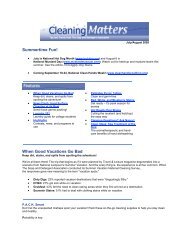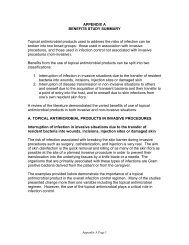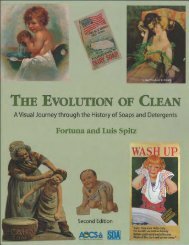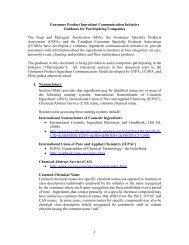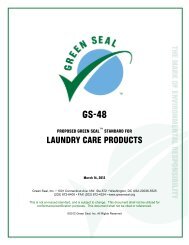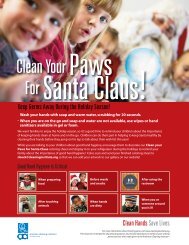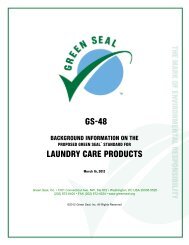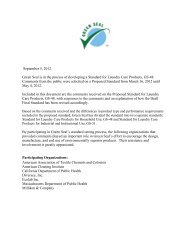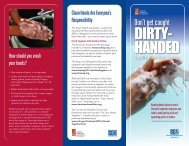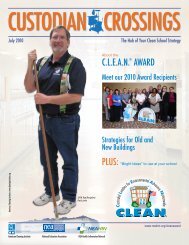subchapter c -- federal hazardous substances act regulations
subchapter c -- federal hazardous substances act regulations
subchapter c -- federal hazardous substances act regulations
Create successful ePaper yourself
Turn your PDF publications into a flip-book with our unique Google optimized e-Paper software.
16 CFR Ch. II (1–1–05 Edition)—proposed modificication – 6/25/06<br />
and bears an arrow or other indicator pointing<br />
toward or directing the purchaser’s attention to<br />
the display panel on the package where the full<br />
labeling statement appears, or<br />
(ii) In the case of a balloon subject to §<br />
1500.19(b)(2) or a toy or game containing<br />
such a balloon, the principal display panel<br />
bears the statement:<br />
-- 35 --<br />
and bears an arrow or other indicator pointing<br />
toward or directing the purchaser’s attention to<br />
the display panel on the package where the full<br />
labeling statement appears.<br />
(g) Alternative for products manuf<strong>act</strong>ured<br />
outside the United States. In the case of a<br />
product subject to the labeling requirements of<br />
§ 1500.19(b) which is manuf<strong>act</strong>ured outside<br />
the United States and is shipped directly from<br />
the manuf<strong>act</strong>urer to the consumer by United<br />
States mail or other delivery service in an<br />
immediate package that contains descriptive<br />
material, the descriptive material inside the<br />
immediate package of the product need not<br />
bear the required labeling statement only if the<br />
shipping container of the product contains<br />
other accompanying material that bears the<br />
required statements displayed in a prominent<br />
and conspicuous manner. Products shipped<br />
from abroad to a U.S. affiliate for shipment to<br />
consumers are included within the scope of<br />
this exception.<br />
(h) Preemption. Section 101(e) of the<br />
Child Safety Protection Act of 1994 prohibits<br />
any state or political subdivision of a state<br />
from en<strong>act</strong>ing or enforcing any requirement<br />
relating to cautionary labeling addressing<br />
small parts hazards or choking hazards<br />
associated with any toy, game, marble, small<br />
ball, or balloon intended or suitable for use by<br />
children unless the state or local requirement is<br />
identical to a requirement established by<br />
section 24 of the FHSA or by 16 CFR<br />
1500.19. Section 101(e) allows a state or<br />
political subdivision of a state to enforce a<br />
nonidentical requirement relating to cautionary<br />
labeling warning of small parts hazards or<br />
choking hazards associated with any toy<br />
subject to the provisions of section 24 of<br />
FHSA until January 1, 1995, if the nonidentical<br />
requirement was in effect on October<br />
2, 1993.<br />
§ 1500.39 Methods of testing <strong>hazardous</strong><br />
<strong>substances</strong>.<br />
In order to determine the appropriate<br />
cautionary labeling it is necessary to have<br />
objective criteria by which the existence of<br />
each hazard can be determined. However, it is<br />
important to keep in mind that neither the<br />
FHSA nor these <strong>regulations</strong> require the<br />
performance of any animal tests. The statute<br />
and these <strong>regulations</strong> require only that a<br />
product be labeled to reflect the hazards<br />
associated with that product. Therefore, in<br />
making the appropriate hazard determinations,<br />
existing alternatives should be utilized when<br />
possible. While animal testing may be<br />
necessary in some cases, such tests should be<br />
limited to the lowest feasible number and<br />
taking every feasible step to eliminate or<br />
reduce the pain or discomfort that can be<br />
associated with such tests. Prior human<br />
experience, literature sources which record<br />
prior animal testing or limited human tests,<br />
and expert opinion all are sources of such<br />
information. Further, as alternatives to the<br />
methods specified in this <strong>subchapter</strong>, tests that<br />
are conducted according to internationally<br />
recognized scientific principles can be used for<br />
purposes of a determination of health and<br />
physical hazards. The criteria for determining<br />
health and physical hazards are test method<br />
neutral, allowing different approaches as long<br />
as they are scientifically sound and produce<br />
acceptable data. For example, inter alia, data<br />
developed according to OECD Test Guidelines<br />
are acceptable, as are data developed<br />
according to methods recognized by the World



